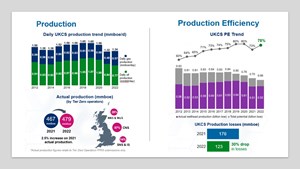NSTA: 22 major energy security projects targeting 1.5 Bbbl in progress to accelerate energy transition
(WO) – Major North Sea energy operators have met to discuss future opportunities and get clear messages on energy security, driving down emissions, and the importance of accelerating the transition at an annual meeting organized by the North Sea Transition Authority (NSTA).
Seven projects capable of producing almost 100 MMbbl and requiring about £1.1 billion ($1.2 billion) of expenditure have been approved by the NSTA since the start of 2022. They can significantly boost the UK’s security of supply during the transition once production starts up. In addition, operators plan to progress 22 projects in the coming years which, subject to robust emissions checks, would target 1.5 Bbbl.
The figures, which highlight the scale of remaining potential in the North Sea, were presented to managing directors of the 22 largest North Sea operators at the annual Tier Zero performance review meeting. The NSTA uses world-class data, including from the UKCS Stewardship Survey, and benchmarking insights to show operators how they compare to highlight best practice and challenge those who need to improve. This approach has been proven to raise standards across the industry.
At last year’s Tier Zero, the NSTA challenged operators to get their production efficiency back on track following a drop of seven percentage points to 73% in 2021 amid widespread maintenance shutdowns. Encouragingly, production efficiency, which indicates how well companies are using their assets, went up to 78% in 2022. The NSTA will continue working with operators to help them restore it to the longstanding target of 80%.
The industry was praised for recent emissions reductions, including from flaring, which has been halved since 2018. These reductions are expected to continue, with companies highlighting dozens of plans to improve energy efficiency and reduce flaring. However, operators must do more if they are to meet the NSTA’s expectation of eliminating routine flaring and venting by 2030.
Operators must also invest in powering their platforms with clean electricity to meet and surpass the North Sea Transition Deal target of lowering overall production emissions by 50% by 2030 and preserve their social license to operate. The NSTA expects decisions to be made this year on the preferred development options for at least two electrification projects.
In addition, options to repurpose and reuse oil and gas infrastructure for low-carbon projects including hydrogen and carbon storage are being identified, forming another pillar of the NSTA’s drive to integrate the UK’s offshore energy systems and accelerate the transition to net zero.
The NSTA will soon give more impetus to the transition by announcing the awards for the UK’s first ever carbon storage licensing round, which received 26 bids from 19 companies. Additional licensing rounds will be needed to meet the UK’s storage requirements and the NSTA is collaborating with government and other regulators to determine the timing of future activities.
Stuart Payne, NSTA Chief Executive, said, “The North Sea boasts a vast array of oil and gas, wind and storage resources which can secure the UK’s supply of cleanly-produced energy, rapidly reduce its greenhouse gas emissions, and support hundreds of thousands of skilled jobs. The NSTA will lead the way on efforts to integrate these resources, optimizing their enormous potential.”



